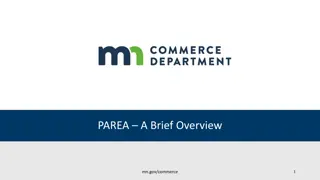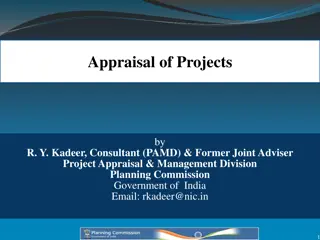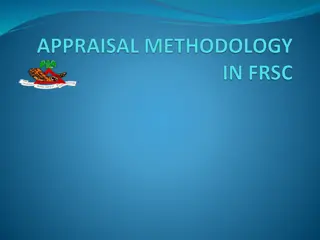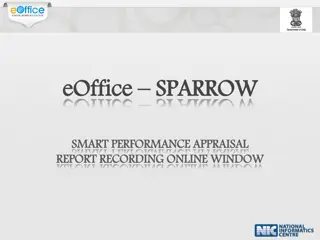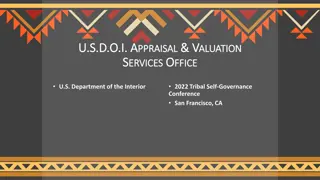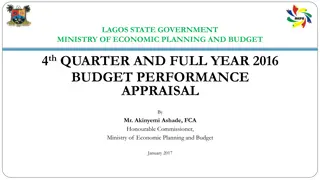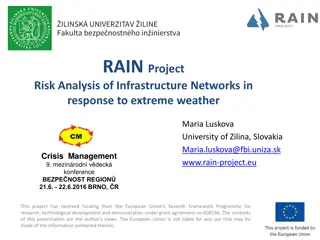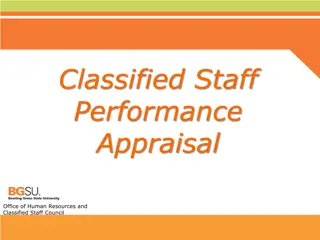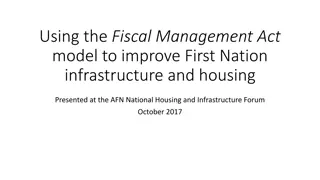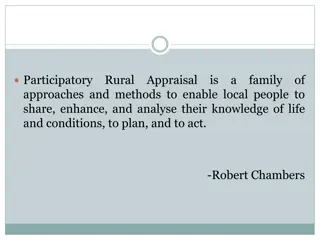Technical Appraisal of Infrastructure Development Project
A detailed discussion on the investment project cycle, investment project appraisal, technical appraisal with components and techniques, and decision factors. Includes a case study on Rural Connectivity Improvement Project (RCIP). Raises critical questions regarding design, engineering, organizational capacity, economic impact, and financial viability. Investment appraisal methods like IRR, NPV, and payback period are emphasized to evaluate project attractiveness. Investment appraisal techniques are crucial in determining the viability of investments, projects, or programs by assessing the value they generate.
- Infrastructure Development
- Investment Project
- Technical Appraisal
- Rural Connectivity
- Investment Appraisal
Download Presentation

Please find below an Image/Link to download the presentation.
The content on the website is provided AS IS for your information and personal use only. It may not be sold, licensed, or shared on other websites without obtaining consent from the author. Download presentation by click this link. If you encounter any issues during the download, it is possible that the publisher has removed the file from their server.
E N D
Presentation Transcript
NASC: Technical Appraisal of Infrastructure Development Project (25 Baisakh, 2075) Ram Krishna Sapkota Joint Secretary, MoFAGA
Outline of Discussion Part One: Investment Project Cycle Investment Project Appraisal Technical Appraisal (components and techniques) and Associated Aspects and Decision Factors Part Two: Case Study of Rural Connectivity Improvement Project (RCIP) Group Work
Project The whole complex of activities for which money will be spent in expectation of returns
Some Questions 1) Is the multi span bridge soundly designed and engineered? Does it meet acceptable standards? Will it displace local people in approach roads? Will it affect the environment in any adverse way? (Technical) 2) Does the borrower have the organization, the management, the staff, the policies to build an Fast Track and maintain it? If not, what changes are required to put these into place?(Institutional) 3) Will the benefits of a water supply and sanitation system outweigh the costs? What will its impact be on family incomes? Will it provide job opportunities for local people? What is the estimated rate of return on the investment? (Economic) 4) Is the borrower's financial plan sound? Is the expressway financially viable? Is the proposed accounting system adequate? Is the counterpart fund available as promised? (Financial) Project Appraisal is to find out whether the project is prima facie acceptable.
Investment Appraisal An evaluation of the attractiveness of an investment proposal, using methods such as average rate of return, internal rate of return (IRR), net present value (NPV), or payback period. Investment appraisal is an integral part of capital budgeting, and is applicable to areas even where the returns may not be easily quantifiable such as personnel, marketing, and training. http://www.businessdictionary.com/definition/investment-appraisal.html
Investment Appraisal Definition Investment appraisal is a collection of techniques used to identify the attractiveness of an investment. https://www.apm.org.uk/body-of-knowledge/delivery/financial-cost-management/investment- appraisal/ Purpose: The purpose of investment appraisal is to assess the viability of project, program or portfolio decisions and the value they generate. The primary objective of investment appraisal is to place a value on benefits so that the costs are justified.
Appraisal for Investment Project Financing Development Cooperation Policy National Priority Areas Country Partnership Strategy Project financing depends on Country Environment Implementation Capacity
The project cycle considers the logical sequence of events from project identification to ex post monitoring and evaluation Project Cycle The World Bank Project Development ADB Identification Preparation Evaluation Implementation and Supervision Appraisal Negotiation and Board Approval
Project Cycle 1) The project cycle is the framework used to design, prepare, implement, and supervise projects. 2) The duration of the project cycle depends on its nature, size and complexity. 3) Normally, a project requires more than five years in our context; from the time it is identified until the time it is completed.
Project Cycle Project Identification Impact Evaluation: Project Preparation Operation and Maintenance: Project Appraisal and Approval Project Implementation
Project Cycle: WB Financed Infrastructure Project Appraisal is done after the feasibility study is carried out
The World Bank Project Cycle (Contd.) 1) A six-step process governs the World Bank's approach to investment lending. 2) It is the Bank's way of making sure that all projects receiving funding from the bank meet the same set of rigorous standards. 3) Bank staff work closely with developing country borrowers throughout the project cycle. 4) The Bank maintains an independent evaluation department to assess the effectiveness of the projects it supports.
Project Development Phase Concept Paper Why is this investment required? Project Preparation Team with experts inputs (PPTA) Approach Paper/Technical Paper CPS, Project Appraisal Document (DP s has its own name like PAD, RRP, Project Document etc.) PPTA and Approval Negotiation (between GON team and DP) Board Approval (ADB, The WB) Financing Agreement between GON and DP (Development Grant/Loan Agreement)
Core of Project Appraisal Focuses on detailed Evaluation of Feasibility Study
Project Appraisal Decision Factors The appraisal of a project involve the examination of: 1) Technical Feasibility : To determine the suitability of the technology selected and the adequacy of the technical investigation, and design. 2) Economic Feasibility : To determine the conduciveness of economic parameters to setting up the project and their impact on the scale of operations. It also contains Market Demand/Survey providing rationale for undertaking the Project. 3) Financial Feasibility : To determine the accuracy of cost estimates, suitability of the envisaged pattern of financing and general soundness of the capital structure. 4) Commercial Viability : To ascertain the extent of profitability of the project and its sufficiency in relation to the repayment obligations pertaining to term finance (eg. Toll Roads).
Project Appraisal Decision Factors 5) Managerial Competency : To ascertain that competent HRs are behind the project to ensure its successful implementation and efficient management after commencement of commercial production. Legal Aspects the value of an investment may enable an organisation to meet current or future legislation; Environmental Aspects the impact of the work on the environment is increasingly a decision factor when considering an investment; Social Safeguards return on investment could be measured in terms of quality of life or even lives saved ; Operational benefits may be expressed in terms of increased customer satisfaction , higher staff morale or competitive advantage ; Implementation Risks all organisations are subject to business and operational risk. An investment decision may be justified because it reduces risk. 6) 7) 8) 9) 10)
The WB - Project Appraisal 1) Appraisal gives stakeholders an opportunity to review the project design in detail and resolve any outstanding questions. The government and the WB review the work done during the identification and preparation phases and confirm the expected project outcomes, intended beneficiaries and evaluation tools for monitoring progress. Agreement is reached on the viability of all aspects of the project at this time. The Bank team confirms that all aspects of the project are consistent with all WB operations requirements and that the government has institutional arrangements in place to implement the project efficiently. All parties agree on a project timetable and on public disclosure of key documents and identify any unfinished business required for final Bank approval. The final steps are assessment of the project's readiness for implementation and agreement on conditions for effectiveness (agreed upon actions prior to implementation). The Project Information Document (PID) is updated and released when the project is approved for funding. 2) 3) 4) 5) 6)
PROJECT APPRAISAL Project Appraisal should also contain the following: 1) Particulars of the project along with a copy of the Project Feasibility Report furnishing details of the technology, construction process, availability of construction / production materials and labour etc. 2) Estimates of Cost of the project with the detail of component wise costs 3) Details of the proposed means of financing indicating the extent of GON, beneficiaries and DP s contribution etc. for the construction and O&M of the facility. 4) Working Capital requirements at the peak level during the construction 5) Project Implementation Schedule review in the light of actual implementation; Main stages in the project implementation and whether the time schedule for construction, erection/installation of P&M, start- up/trial run, commencement of operation is reasonable &acceptable 6) Quality Assurance testing /monitoring mechanism to ensure quality of works 7) Grievance Redressed Mechanism institutional arrangements to strengthen project governance
Technical Feasibility 1) The main objective of a technical feasibility study is to determine whether a certain plan of action is feasible technically or not that is, will it work? 2) A technical feasibility is applied to all investment projects in order to better understand if the project can be done technically and whether it can be done here at the proposed site and now 3) The assessment identifies, through a professional peer review, whether the best practices and procedures are used to improve the delivery of proposed investment. 4) The assessment output becomes a valuable road map for the EA/IA to identify strategic opportunities that maximize associated due to the investment.
Features of Technical Feasibility Technology and techniques: 1) Do the technology and techniques required to deliver this project exist locally or globally? 2) Have they been used before? If a new technology or technique is needed, how confident are we in its success (eg. Otta Seals)? Technical capacity/skills: 1) Do the necessary skills available locally to design and implement the project? 2) Have they been used before? Human and Financial resources: 1) What is the scope of human and financial (budget) resources required to implement the project? 2) Will the human resources be accessible, and how might costs change during the life of the project (operational, maintenance, etc.)?
Technical Appraisal 1) Provides the rationale for the selected technical design or options, its appropriateness to the requirements, and its conformity with approved standards and guidelines and relevant international best practices. 2) Ensures that the project schedule does not incorporate concurrency to hasten the project. 3) Recommends suitable arrangements for overall project management, i.e. the systems required for financial management, procurement, reporting, and monitoring and evaluation. 4) All that glitters is not gold - technology from a multinational does not necessarily mean the most appropriate in the given context.
Technical Appraisal 1) The technology and design should be one already tested and established. The know-how already available within the country and currently in use should be explored and compared with that envisaged in the project. 2) It is desirable to find the state-of-the-art technology relevant to the project and weigh and measure the same vis-a-vis the technology proposed in the project appraised. 3) The aim is to have the best possible know-how (most suitable with the economic environment) already established with higher grade quality and productivity, if possible, from the relevant technical collaborator. 4) We are to recognize that project without the latest technology ultimately leads to obsolescence, higher cost and, as such, extreme difficulty in withstanding competition. The latest technology may be, on the other hand, a Costly proposition in the initial stage but economic in the long run.
Technical Aspects of Project Appraisal This is mainly concerned with issues related to 1) Physical scale, layout, location of facilities, 2) Technology used, 3) Cost estimates and their relation to engineering or other data on which they are based, 4) Proposed procurement arrangements, 5) Procedures for obtaining engineering, architectural or other professional services, 6) The potential impact on the human and physical environment, and 7) A range of other similar concerns related to the technical adequacy and soundness of the project. For instance, in the technical appraisal of an educational project considerations will have to be given to the curriculum, the number and nature of educational establishments, their physical facilities (classroom, space, laboratories, libraries, and equipment), personnel, skills gaps and training requirements, etc. Source: Project Appraisal and Impact Analysis,University of London
Components of Technical Appraisal Whether pre-requisites for the success of project considered? 1) Per capita water demand, adequacy of the water source, Treatment Technology proposed, Technical Human Resources availability, Water tariff and O&M Cost etc. WSS Project, 2) AADT, Right of way and deed transfer, Environmental clearance, Road side structures, Pavement type, Construction materials availability, Possibility of traffic diversion during construction , per km cost etc. Road construction project 3) Per Ha irrigation water available, construction technology adopted, cash crop, irrigation service fee and O&M cost Irrigation service improvement project 4) Appropriate choices with regard to facility location (alternative alignment, WS route, reservoir site, Diversion head works site), size, technology (Slow sand filter vs rapid sand filter; Double Otta seals vs. DBST), process (Gravity fed vs. pumping fed) etc.
Technical Appraisal The cautions in general in this area are: 1) The details of the designs should be thoroughly reviewed to minimize the technical risk. In technically complex and sensitive designs, all design proposals should be fully investigated. 2) Innovative design should be distinguished. It may appear safe and less costly but later on may escalate up to an awkward situation when it is too late. 3) The appraisal should ensure that the project has minimum of technical uncertainty and resolve uncertainty, if any, on a priority basis. 4) Technical Design should be simple to understand and implement ; not have unnecessarily burdensome specifications. 5) Ensure cost effective, technically simple to operate, O&M friendly design options 6) In-house technical capacity, and outsourcing requirements to construct and operate the facility
Techniques of Technical Appraisal 1) Involvement of the tam of experts of different thematic areas as per the requirements of the proposed project ( for a rural road project: Public procurement, Institutional, Financial, Environmental, Social Safeguards, Geo technical, Highway, Bridge etc.) 2) Assessment of design and cost options (peer review) 3) Stakeholders consultation 4) Field verifications of critical issues 5) Tradeoff between technology choice and affordability
Basis for and Method of Project Approval Financial Procedural Rules Schedule-3 (Relating to Sub-rule (1) of Rule 22)
(i) Basis for Project Approval The Competent Authority shall approve a project or program only on the basis of the following data and information : 1.1 Structure of the project : 1.1.1 Objectives of the project 1.1.2 Scope of the Project 1.1.3 Project execution period (Project Duration) 1.2 Total cost estimate of the project : Rs. 1.2.1 Development and construction cost 1.2.2 Operational cost 1.2.3 Others (If any grant has to be given, specify it).
(i) Basis for Project Approval (Contd.) 1.3 Source to bear the cost : 1.3.1 Government of Nepal 1.3.2 External aid: Loan, Grant 1.4 Returns from the project : 1.4.1 Support or contribution to the growth of production. 1.4.2 Increase in employment 1.4.3 Internal returns of the project 1.4.4 Other economic and social consideration: Economic, Social 1.5 Economic analysis of the project (IRR, NPV, CEA, MCA etc.) 1.6 Project execution and expenditure schedule (Financing Plan) 1.7 Human resource and major construction materials required to execute the project 1.8 Project Operation Proposal
(ii) The process and authority to approve the project 2.1 The Ministry shall seek advice of the NPC as to whether the proposed project is in consonance with the objective of national development, sectoral working policy or not and whether it is included in the approved periodical plan or not. 2.2 Recommendation that the bases of expenditure proposed for the project works are reasonable on the basis of the prevailing price, profit, cost expenditure shall have been made by the DG presenting the project report. 2.3 The concerned Ministry shall, taking into consideration of the advice of the NPC, approve and execute the project as follows : (a) In cases where the proposed project is included in the approved periodic plan and it appears that the project will yield benefit and incur expenditure as mentioned in that plan and the NPC has given positive opinion, the concerned Ministry is to give approval.
(ii) The process and authority to approve the project (Contd.) (b) In cases where project which is not included in the approved national periodic plan or which incurs more financial liability than that set aside in that plan has to be operated, the opinion of the NPC and the MOF shall be taken. (c) If the opinion of the NPC or the MOF be not positive, the concerned Ministry shall submit a proposal, accompanied by that opinion, to the Cabinet. It shall be as decided in that respect. 2.4 In submitting the project proposal, a project operation plan on operation of the project in a smooth and sustainable manner following the completion of the project shall also have been submitted, along with the recommendation, by the DG presenting the project report. 2.5 In addition to the above-mentioned bases, such procedures as may be necessary for the propose of making the project/office disciplined and strengthened may be made clear by the GON from time to time. ***
Huge Gap Exists in.. Project Preparation Project Duration Quality Procurement/ Disbursement Contract Implementation Financial Management
Project Management Issues 1) 2) 3) 4) Obstacles in land acquisition by the land owners. Substantially high demand for land compensation. Very difficult to implement Donors resettlement guidelines Shortage of skilled manpower/professionals in the country: brain drain. Bilateral Donors interest in direct funding. Continuity of key project staff during project implementation Reluctance of contracting authorities to take legal actions against the non-performers. Quality of work issue: no field supervision- resulting low quality of works value for money?. Frequent shortage of construction materials for development projects. 5) 6) 7) 8) 9)
Project Management Issues 10) Lack of strong ownership and mutual accountability in Project preparation to implementation 11) Inadequate coordination and cooperation among the stakeholders 12) Weak communication with the beneficiaries leading to escalating demands from the local people. 13) Inconsistency of message from project staff to the beneficiaries 14) Weak transfer/handover of institutional memory; (DPs blame IA and vice versa) 15) Inadequate follow up, M&E and feed back for closing the loop.
Case Study: RRP - Rural Connectivity Improvement Project (RCIP): DUE DILIGENCE A. Technical 19. DOLIDAR prepared the detailed design of the project roads (388 km) using its own resources and is compliant with the government s standards and specifications for rural roads to improve project readiness. The project adopted environmentally friendly road construction practices and a participatory approach in project preparation through transect surveys, which enhanced the climate-resilience aspect of the design. These practices emphasize the use of (i) Existing alignments proposal is to upgrade the roads; (ii) Mass-balancing to minimize soil and vegetation disturbance and risk of erosion; (iii) Flexible, porous gabions to stabilize steep slopes; and (iv) Bio-engineering to minimize erosion from exposed soils, while the participatory approach incorporates local knowledge into the design of sections that are prone to flooding and erosion.
RRP is the output of Project Appraisal
Class Work Technical Appraisal of an Infrastructure Development Project 1) Rural Road Improvement Project (RRIP): Province 6 and 7; project of 5 years period, 1000 km AC surfacing 2) Farmers Managed Irrigation Project (FMIP): 22000 Ha, in 10 Terai and 10 Mid hill districts in 5 years period 3) Rural Water Supply And Sanitation Scheme (RWSSS) in a community with 1000 households @ 45 lpcd, available water source is in the middle of the settlement.
Thank You for Your Attention!



